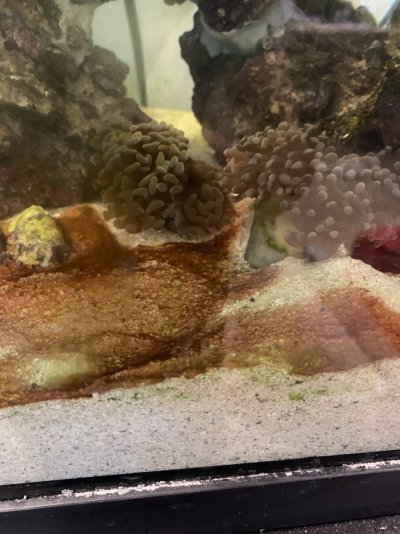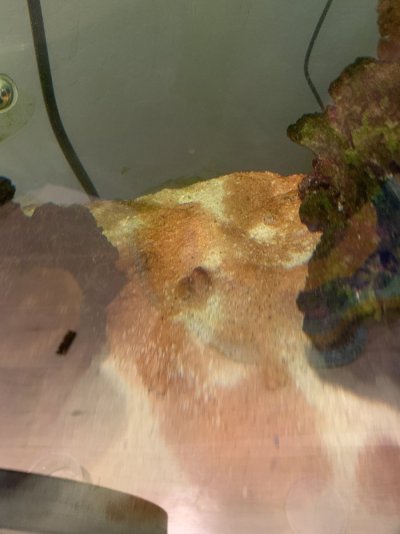Navigation
Install the app
How to install the app on iOS
Follow along with the video below to see how to install our site as a web app on your home screen.
Note: This feature may not be available in some browsers.
More options
You are using an out of date browser. It may not display this or other websites correctly.
You should upgrade or use an alternative browser.
You should upgrade or use an alternative browser.
Orange algae all over sand turning stringy what to do
- Thread starter GpixL_
- Start date
- Tagged users None
Turkey baster blast, remove with turkey baster (suction) or fingers, looks like start of uglies, remove as much as possible, then prepare to do the same in a couple of days,
UV filter helps
UV filter helps
Looks like Cyanobacteria to me .
a normal ugly part of maturing .
a normal ugly part of maturing .
Even though it’s hairy?Looks like Cyanobacteria to me .
a normal ugly part of maturing .
Yup it’s CyanoEven though it’s hairy?
Great thanks so just syphon and it’ll go away?Yup it’s Cyano
Usually cyano presents when nutrients are low or out of balance (especially nitrates lower than phosphates) so I would investigate the root cause and try to correct, but manual removal works.
Its not very harmful if its just on the sand like that but if it starts to form thick mats or encroach on corals it might be time for more drastic actions.
One common treatment used to control cyano is called chemiclean but would only recommend it if the outbreak is severe enough to effect coral health. In my experience, if directions are followed with proper dosage, it doesnt seem to hurt anything aside from possible nutrients spike immediately following dosage as well as pH / oxygen decrease during treatment -- you would need to supply oxygen with air pump or allow skimmer to overflow into sump to keep o2 up during a treatment. Again, only recommend as final option to eradicate.
If the root cause is not addressed then no matter what action you take the cyano will return/persist.
Its not very harmful if its just on the sand like that but if it starts to form thick mats or encroach on corals it might be time for more drastic actions.
One common treatment used to control cyano is called chemiclean but would only recommend it if the outbreak is severe enough to effect coral health. In my experience, if directions are followed with proper dosage, it doesnt seem to hurt anything aside from possible nutrients spike immediately following dosage as well as pH / oxygen decrease during treatment -- you would need to supply oxygen with air pump or allow skimmer to overflow into sump to keep o2 up during a treatment. Again, only recommend as final option to eradicate.
If the root cause is not addressed then no matter what action you take the cyano will return/persist.
I would Check your nutrients, cyano is bacterial. However yes, siphon and and water change is a good startGreat thanks so just syphon and it’ll go away?
vetteguy53081
Well known Member and monster tank lover
View Badges
Partner Member 2024
Excellence Award
Reef Tank 365
RGB
Article Contributor
Tampa Bay Reef Keepers
West Palm Beach Reefer
Hospitality Award
Ocala Reef Club Member
305 Reef Club
Wisco Reefers
Midwest Reefer
Fish Medic
MAC of SW Florida
Rock Pool Reef Keepers
R2R Secret Santa 2023
My Tank Thread
My Aquarium Showcase
Its Cyano for sure
Cyano blooms typically start when water nutrient concentrations go haywire and when concentrations of phosphate, nitrate and other organic compounds are too high.
Some of the most common causes include:
- Protein skimmer which fills water with tiny air bubbles. As bubbles form from the reaction chamber, dissolved organic compound molecules stick to them. Foam forms at the surface of the water and is then transferred to a collection cup, where it rests as skimmate. When the protein skimmer does not output the best efficiency or you do not have the suitable protein skimmer to cover the tank, the air bubbles created by the skimmer might be insufficient. And this insufficiency of air bubbles can trigger the cyano to thrive.
- Overstocking / overfeeding, your aquarium with nutrients is often the culprit of a cyano bloom
- Adding live rock that isn’t completely cured which acts like a breeding ground for red slime algae
- If you don’t change your water with enough frequency, you’ll soon have a brightly colored red slime algae bloom. Regular water changes dilute nutrients that feed cyanobacteria and keeps your tank beautifully clear
- Using a water source with nitrates or phosphates is like rolling out the welcome mat for cyano. Tap water is an example
- Inadequate water flow, or movement, is a leading cause of cyano blooms. Slow moving water combined with excess dissolved nutrients is a recipe for pervasive red slime algae development
I recommend to reduce white light intensity or even turn them off for 5-7 days. Add liquid bacteria daily for a week during the day at 1.5ml per 10 gallons. Add Hydrogen peroxide at night at 1ml per 10 gallons. Add a pouch of chemipure Elite which will balance phos and nitrate and keep them in check.
After the week, add a few snails such as cerith, margarita, astrea and nassarius plus 6-8 blue leg hermits to take control.
Cyano blooms typically start when water nutrient concentrations go haywire and when concentrations of phosphate, nitrate and other organic compounds are too high.
Some of the most common causes include:
- Protein skimmer which fills water with tiny air bubbles. As bubbles form from the reaction chamber, dissolved organic compound molecules stick to them. Foam forms at the surface of the water and is then transferred to a collection cup, where it rests as skimmate. When the protein skimmer does not output the best efficiency or you do not have the suitable protein skimmer to cover the tank, the air bubbles created by the skimmer might be insufficient. And this insufficiency of air bubbles can trigger the cyano to thrive.
- Overstocking / overfeeding, your aquarium with nutrients is often the culprit of a cyano bloom
- Adding live rock that isn’t completely cured which acts like a breeding ground for red slime algae
- If you don’t change your water with enough frequency, you’ll soon have a brightly colored red slime algae bloom. Regular water changes dilute nutrients that feed cyanobacteria and keeps your tank beautifully clear
- Using a water source with nitrates or phosphates is like rolling out the welcome mat for cyano. Tap water is an example
- Inadequate water flow, or movement, is a leading cause of cyano blooms. Slow moving water combined with excess dissolved nutrients is a recipe for pervasive red slime algae development
I recommend to reduce white light intensity or even turn them off for 5-7 days. Add liquid bacteria daily for a week during the day at 1.5ml per 10 gallons. Add Hydrogen peroxide at night at 1ml per 10 gallons. Add a pouch of chemipure Elite which will balance phos and nitrate and keep them in check.
After the week, add a few snails such as cerith, margarita, astrea and nassarius plus 6-8 blue leg hermits to take control.
Will do thanksIts Cyano for sure
Cyano blooms typically start when water nutrient concentrations go haywire and when concentrations of phosphate, nitrate and other organic compounds are too high.
Some of the most common causes include:
- Protein skimmer which fills water with tiny air bubbles. As bubbles form from the reaction chamber, dissolved organic compound molecules stick to them. Foam forms at the surface of the water and is then transferred to a collection cup, where it rests as skimmate. When the protein skimmer does not output the best efficiency or you do not have the suitable protein skimmer to cover the tank, the air bubbles created by the skimmer might be insufficient. And this insufficiency of air bubbles can trigger the cyano to thrive.
- Overstocking / overfeeding, your aquarium with nutrients is often the culprit of a cyano bloom
- Adding live rock that isn’t completely cured which acts like a breeding ground for red slime algae
- If you don’t change your water with enough frequency, you’ll soon have a brightly colored red slime algae bloom. Regular water changes dilute nutrients that feed cyanobacteria and keeps your tank beautifully clear
- Using a water source with nitrates or phosphates is like rolling out the welcome mat for cyano. Tap water is an example
- Inadequate water flow, or movement, is a leading cause of cyano blooms. Slow moving water combined with excess dissolved nutrients is a recipe for pervasive red slime algae development
I recommend to reduce white light intensity or even turn them off for 5-7 days. Add liquid bacteria daily for a week during the day at 1.5ml per 10 gallons. Add Hydrogen peroxide at night at 1ml per 10 gallons. Add a pouch of chemipure Elite which will balance phos and nitrate and keep them in check.
After the week, add a few snails such as cerith, margarita, astrea and nassarius plus 6-8 blue leg hermits to take control.
I would never recommend in tank dosage of hydrogen peroxide to any reefer fwiw. I would never ever dose hydrogen peroxide into our work systems.
Ive dosed it plenty in my personal aquarium at home and its never done anything helpful ever. It does kill ugly stuff but it also wrecks everything else in your tank too including your bio filter, etc.
Addressing the root cause and utilizing recognized treatment methods will be best chance of success~
Ive dosed it plenty in my personal aquarium at home and its never done anything helpful ever. It does kill ugly stuff but it also wrecks everything else in your tank too including your bio filter, etc.
Addressing the root cause and utilizing recognized treatment methods will be best chance of success~
Similar threads
- Replies
- 2
- Views
- 99
- Replies
- 8
- Views
- 194
- Replies
- 14
- Views
- 215
- Replies
- 2
- Views
- 129
















